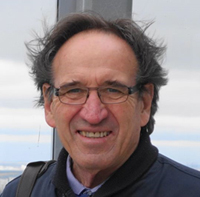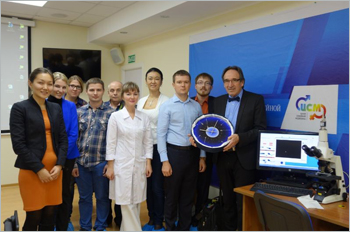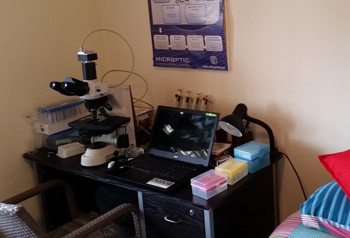Personal interview to Microptic senior consultant and Blogger, Gerhard van der Horst
Before holidays we want to offer you this interesting personal interview to Emeritus Prof Gerhard van der Horst (PhD, PhD) of Department of Medical Biosciences, University of the Western Cape, South Africa. In this interview Prof. van der Horst talks about himself, his job, how he lives the evolution in the field of Assisted Reproductive Technologies and more.
How would you define yourself?
 I am a passionate spermatologist who was fortunate to have worked and personally known the very best scientists/mentors in the field since the age of 20, like Drs Polge, Thaddeus Mann, Hector Dott, Tim Glover (now almost 90) Elliasson, Bjorn Afzelius, Baccio Baccetti and many others. They have changed my life and I have never looked back.
I am a passionate spermatologist who was fortunate to have worked and personally known the very best scientists/mentors in the field since the age of 20, like Drs Polge, Thaddeus Mann, Hector Dott, Tim Glover (now almost 90) Elliasson, Bjorn Afzelius, Baccio Baccetti and many others. They have changed my life and I have never looked back.
During all the years that you are working with CASA System you have seen a revolution in the field of Assisted Reproductive Technologies. Explain to us how do you start in this field and what evolution you’ve observed.
I was still at school when the first test tube baby, Louise Brown, was born. The Cambridge spermatologist Robert Edwards whom I have personally known professionally later on, received the Nobel prize for this work a few years ago. One of the challenges then and now is how to define good sperm quality/functionality.
In the 1970’s groups in the USA, England and South Africa (my lab) started with capturing video images of sperm and then replay it frame by frame and on transparencies constructed the tracks. This took forever but was objective and not subjective.
The next step influenced my career by working with Hector Dott in Cambridge in 1978 who had the first fully automated sperm motility analyzer built by Cambridge instruments and it filled half a room (only one built ever). Amazingly the well-known David Katz (Motion Analysis) as well as Diarmaid Douglas Hamilton (of Hamilton Thorne fame) also worked in Hector’s lab for short periods and all three of us developed our own CASA systems in the late 1980’s /early 90’s. My system was called SMQ (sperm motility quantifier) but was a DOS based system. So when Windows arrived in 1995 it was too costly for me to make it Windows friendly (very difficult those years). Many MSc and PhD students used it and we must have published about a dozen papers using this old workhorse up to 2007.
A new chapter then arrived which again influenced my career and life dramatically: I bought a SCA 3.1 CASA system from Microptic in 2007 and then became a consultant for them since 2008 due to great mutual understanding between me and Mr. Bellver of Microptic. In retrospect this up to now has been some of the most exciting times of my life. We formed almost naturally a great team and in particular I was so fortunate to work with brilliant bio-engineer, Eduard Sanchez of Microptic. We almost have an intuitive understanding of what is the next step. I was accordingly very fortunate to be involved in the development of the most advanced and top class CASA system in the world. But of course as a whole it was and is a Microptic team effort where we all support each other.
The developments of SCA over more than 16 years changed the concept of CASA totally by not only making it a system which is clinically usable and can be trusted but also that it was very early realized that more modules should be designed that helps define sperm functionality in both humans and animals. So yes I was fortunate to live this CASA revolution in ART since its very inception in 1970’s.
How do you live your job?
My work (95%) spermatology is my life, is my passion is almost everything to me. I am also extremely devoted to my research and when in Cape Town typically work seven days a week and for most days more than 12 hours per day. I still supervise five PhD and 2 MSc students. I also have a full CASA lab in my apartment overlooking the sea and Table Mountain and spend also many hours behind the microscope. I am a “lab rat” and love to work next to my students.
- View from my balcony in Cape Town
- My own CASA lab in my apartment in bedroom
What do you like more of your job and why?

Receiving a nice gift after presenting CASA workshop from Family Planning group in Ekatarinaburg, Russia
While I wear four hats, Emeritus Prof, UWC, Extra-ordinary Prof, Stellenbosch, Microptic consultant and researcher at the National Zool I am strictly retired but work more than ever. However, I really like that I can largely do what I want when I want in general terms and then I normally do what I like – spermatology. So, no meetings (except sperm meetings) no marking of papers, no formal lecturing.
Also I really enjoy all my workshop trips with Microptic all around the world including giving invited papers and influencing people to understand the importance of CASA and its applications. In the process I visited some 27 countries presenting more than 40 CASA related lectures and workshops.
What experiences lived will you never forget?
The greatest research experiences were certainly my involvement in saving the black-footed ferret from extinction a project I did over two decades with my great friend Prof Bob Atherton who recently died at 78) at the University of Wyoming in Laramie, Wyoming, USA. When I arrived there were only 23 black-footed ferrets on the globe. There are now several thousand and some released in the wild again.
But my first love is comparative spermatology and I have worked on sperm of about a 100 different species from sea-urchins and oysters to African elephant, African rhinoceros, African buffalo, African lion and leopard, gazelles, tigers, frogs, fish and many others. All of these had magic moments as these were all either fully wild- free ranging animals or semi-captive. Not possible to forget any of these.
Explain to us the most curious anecdote that should have happened to you working…
I was working on a sedated elephant more than 20 years ago when a four year old elephant suddenly appeared from the bush and somehow running flat out towards me. I discovered this when the elephant was very close (5 seconds away) but fortunately next to me was a big truck and to get on top of it I had to jump and must have set a world record for the high jump and the elephant missing me by two seconds…
How do you explain the term “innovation” in your field?
In our lab we try to understand in novel ways what is really important to do next to understand sperm biology as a whole. Much of this information I try to transplant to practical CASA applications in conjunction with Microptic. It is very exciting but mostly also very challenging and very difficult. In the long run these innovations should pave the way for understanding what is potentially fertile in humans and animals and which combination of parameters and tests should we target.
What will happen in the future?
The future of CASA is very bright! I see two main streams. The cell phone will become the most powerful tool for almost all applications on the globe and it is just logical that initially simple basic CASA applications will be done using the cell phone in conjunction with “lenseless microscopes” that will fit in the pocket of your coat. But this will be more for screening initial semen parameters. The second stream will always be required and will involve typical elaborated CASA systems such as SCA with many modules/applications assisting to better define sperm functionality and take better decisions in terms of IUI/IVF/ICSI. Again Microptic and myself are continuously talking about what should be next. Such exciting times.






Leave A Comment